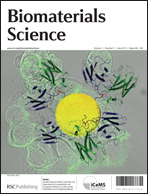Cationic, helical polypeptide-based gene delivery for IMR-90 fibroblasts and human embryonic stem cells
Abstract
Diblock copolymers consisting of poly(ethylene glycol)-block-poly(γ-4-(((2-(piperidin-1-yl)ethyl)amino)methyl)benzyl-L-glutamate) (PEG-b-PVBLG-8) were synthesized and evaluated for their ability to mediate gene delivery in hard-to-transfect cells like IMR-90 human fetal lung fibroblasts and human embryonic stem cells (hESCs). The PEG-b-PVBLG-8 contained a membrane-disruptive, cationic, helical polypeptide block (PVBLG-8) for complexing with DNA and a hydrophilic PEG block to improve the biocompatibility of the gene delivery vehicle. The incorporation of PEG effectively reduced the toxicity of the helical PVBLG-8 block without dramatically compromising the polymer's ability to destabilize membranes or form complexes with DNA. PEG-b-PVBLG-8 copolymers with low (n = 76) and high (n = 287) degrees of polymerization (n) of the PVBLG-8 block were synthesized and evaluated for gene delivery. PEG-b-PVBLG-8 diblock polymers with a high degree of polymerization have a greater transfection efficiency and lower toxicity in IMR-90 cells than the commercial reagent Lipofectamine 2000. The usefulness of PEG-b-PVBLG-8 was further demonstrated via the successful transfection of hESCs without a measured loss in cell pluripotency markers.


 Please wait while we load your content...
Please wait while we load your content...